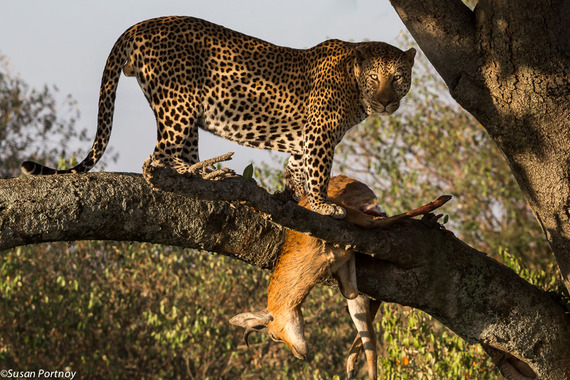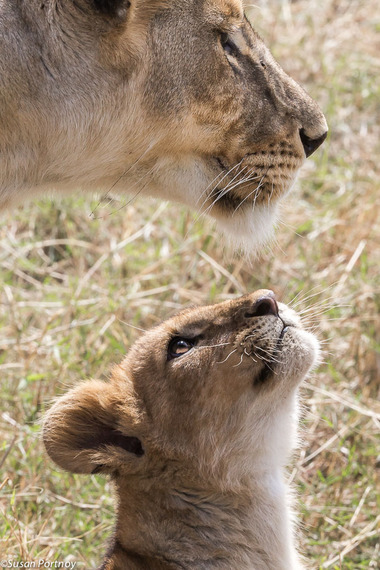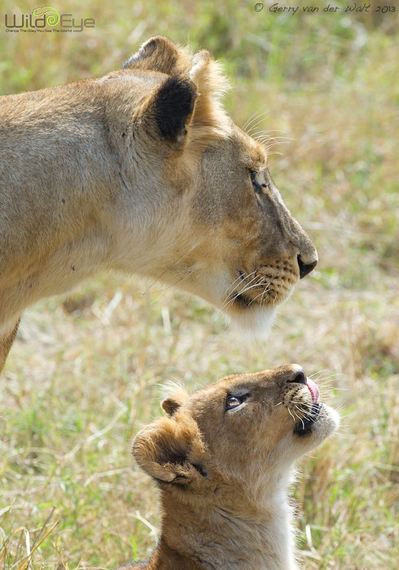Photographing wildlife in Africa is a unique experience, but what I discovered about photography when I shot with professional wildlife photographer Gerry van der Walt, director of Wild Eye, and his team in Kenya this past September was surprisingly universal. Whether in the bush or in your own backyard, you can use these six tips anywhere, anytime.
1. Ask yourself: What's the story I want to tell?
One day on safari I asked Gerry the best way to shoot a scene, and he replied, "Why are you picking up your camera?" At first the question stumped me. Wasn't it obvious? There was a huge leopard in front of the jeep. Gerry smiled and said, "If you think about the actual reason, the story you want to tell, you will be in a much better position to convey this to the people looking at your images."
![2013-12-05-HPtipsSPortnoy_20130908_1816.jpg]()
(I chose to show this leopard with his kill in the tree to underscore him as a predator)
Aha! I thought about that for a moment and realized that typically I didn't have a story in mind when I took a picture. From that point on I did my best to slow down and ask myself what I wanted the images to communicate. Using the leopard as an example, did I want to focus on the beauty of the animal or its fierceness as a predator? Did I want an intimate portrait or to juxtapose him with his environment? Once I started thinking about the story I hoped each photo to tell, it informed how I should take the shot, and I immediately saw an improvement in my images.
2. Remember to turn around
In Africa, the sunsets are so captivating that it's easy to get caught up shooting every second of the sun's descent. But whether you're in Boston or Botswana, if you do, you're capturing only half of the possibilities. Turn around; look at what that fantastic golden light does to the world behind you -- there may be a gem of an image waiting to be captured. This is true for any situation: Don't miss a great shot because you're focused only on what's in front of you.
3. When shooting action, keep the frame wide
This is something I constantly have to remind myself. I love the look of a fabulous close-up, but unless you make the frame wide enough for an active subject, you're likely to chop off something important and ruin the shot. I learned this lesson the hard way watching an adorable cub and its mother interact one morning. I zoomed in too close and got this...
![2013-12-05-HPtipsSPortnoy_20130908_2331.jpg]()
(Momma with her head chopped off)
whereas Gerry, who practices this tip, got this...
![2013-12-05-1185680_624071500947536_1101135235_n.jpg]()
(Momma and cub sitting pretty)
4. Switch up your orientation
People tend to gravitate toward a particular orientation when they shoot. I lean toward the horizontal, or landscape. Unless something is blatantly up and down, such as the Washington Monument, I still have to remind myself to shoot a scene vertically. A photo can take on a whole new expression when you change orientation, and it's well worth the effort to see which way works best for the story you wish to tell.
5. Have patience
At the beginning of my trip, I was so afraid to miss something that I took a lot of so-so pictures just because an exotic animal was in the frame. But the truth is, whether your subject is a majestic elephant or an adorable pug, awful angles, ugly environments, bad lighting and unwanted obstacles spell trouble. I learned that sometimes it's better to simply put down the camera and enjoy the moment. Many times the scene will change and the opportunity for a good photo will present itself; if not, move on. No point in shooting something you'll end up deleting anyway.
6. Number your memory cards
Photographing a cheetah on the run or an active two-year-old child can burn through a ton of memory cards, and keeping them organized can be a job unto itself. Gerry taught me this little trick on while we were setting up our gear: Number your cards, and use them in chronological order. This brilliant frustration-saver enables you to see in a flash which cards are full and those that are empty -- avoiding accidental reformatting or dreaded image deletions.
To see more photos and stories from my adventures, please join me on Facebook.
Do you know some great photography tips? Please share in the comments below.
1. Ask yourself: What's the story I want to tell?
One day on safari I asked Gerry the best way to shoot a scene, and he replied, "Why are you picking up your camera?" At first the question stumped me. Wasn't it obvious? There was a huge leopard in front of the jeep. Gerry smiled and said, "If you think about the actual reason, the story you want to tell, you will be in a much better position to convey this to the people looking at your images."

Aha! I thought about that for a moment and realized that typically I didn't have a story in mind when I took a picture. From that point on I did my best to slow down and ask myself what I wanted the images to communicate. Using the leopard as an example, did I want to focus on the beauty of the animal or its fierceness as a predator? Did I want an intimate portrait or to juxtapose him with his environment? Once I started thinking about the story I hoped each photo to tell, it informed how I should take the shot, and I immediately saw an improvement in my images.
2. Remember to turn around
In Africa, the sunsets are so captivating that it's easy to get caught up shooting every second of the sun's descent. But whether you're in Boston or Botswana, if you do, you're capturing only half of the possibilities. Turn around; look at what that fantastic golden light does to the world behind you -- there may be a gem of an image waiting to be captured. This is true for any situation: Don't miss a great shot because you're focused only on what's in front of you.
3. When shooting action, keep the frame wide
This is something I constantly have to remind myself. I love the look of a fabulous close-up, but unless you make the frame wide enough for an active subject, you're likely to chop off something important and ruin the shot. I learned this lesson the hard way watching an adorable cub and its mother interact one morning. I zoomed in too close and got this...

whereas Gerry, who practices this tip, got this...

4. Switch up your orientation
People tend to gravitate toward a particular orientation when they shoot. I lean toward the horizontal, or landscape. Unless something is blatantly up and down, such as the Washington Monument, I still have to remind myself to shoot a scene vertically. A photo can take on a whole new expression when you change orientation, and it's well worth the effort to see which way works best for the story you wish to tell.
5. Have patience
At the beginning of my trip, I was so afraid to miss something that I took a lot of so-so pictures just because an exotic animal was in the frame. But the truth is, whether your subject is a majestic elephant or an adorable pug, awful angles, ugly environments, bad lighting and unwanted obstacles spell trouble. I learned that sometimes it's better to simply put down the camera and enjoy the moment. Many times the scene will change and the opportunity for a good photo will present itself; if not, move on. No point in shooting something you'll end up deleting anyway.
6. Number your memory cards
Photographing a cheetah on the run or an active two-year-old child can burn through a ton of memory cards, and keeping them organized can be a job unto itself. Gerry taught me this little trick on while we were setting up our gear: Number your cards, and use them in chronological order. This brilliant frustration-saver enables you to see in a flash which cards are full and those that are empty -- avoiding accidental reformatting or dreaded image deletions.
To see more photos and stories from my adventures, please join me on Facebook.
Do you know some great photography tips? Please share in the comments below.